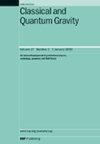膜世界理论下的扩展数据样本
IF 3.6
3区 物理与天体物理
Q2 ASTRONOMY & ASTROPHYSICS
引用次数: 0
摘要
这项工作修正了被称为Randall Sundrum的膜世界理论,修改了一个指数,红移依赖的膜张力。这个模型是在假设没有暗能量的情况下进行研究的,目的是确定它是否可以在不添加暗能量流体的情况下自行重现宇宙的加速。为了约束SLS、SNIa、OHD和BAO四种场景的自由参数,我们进行了贝叶斯统计分析,后两种场景考虑了数据上新增的元素。使用并比较了h的普朗克先验和里斯先验。在这两种情况下,我们都能够再现与观测数据一致的后期加速膨胀。在过渡红移zt与ΛCDM处发现了有趣的一致性,这表明这可能是一个适合研究迄今为止宇宙演化的模型,然而,在这个模型中发现了一些病态,即在z = 1处H(z)的“大撕裂”散度,以及在这个模型中膜张力的泛函形式与宇宙未来演化之间的强烈关系。本文章由计算机程序翻译,如有差异,请以英文原文为准。
Extended datasamples under the lens of Brane World Theory
This work revises the Brane World Theory known as Randall Sundrum with the modification of an exponential, redshift-dependent brane tension. This model is studied in a scenario assuming no dark energy, with the aim of determining whether it can reproduce the Universe’s acceleration on its own, without the addition of a dark energy fluid. Bayesian Statistical analysis is performed in order to constrain the free parameters of each scenario for which the datasamples of SLS, SNIa, OHD and BAO are used, the last two considering newly added elements on the data. Both Planck and Riess priors for h are used and compared. In both cases we are able to reproduce the late-time accelerated expansion in agreement with observational data. Interesting consistencies at transition redshift zt with ΛCDM are found suggesting that this might be a suitable model for studying the evolution of the Universe up to present date, however, some pathologies are detected in this model, namely a ‘Big Rip’ divergence of H(z) at z = 1, as well as a strong relationship between the form of the functional for the brane tension and the future evolution of the Universe in this model.
求助全文
通过发布文献求助,成功后即可免费获取论文全文。
去求助
来源期刊

Classical and Quantum Gravity
物理-天文与天体物理
CiteScore
7.00
自引率
8.60%
发文量
301
审稿时长
2-4 weeks
期刊介绍:
Classical and Quantum Gravity is an established journal for physicists, mathematicians and cosmologists in the fields of gravitation and the theory of spacetime. The journal is now the acknowledged world leader in classical relativity and all areas of quantum gravity.
 求助内容:
求助内容: 应助结果提醒方式:
应助结果提醒方式:


